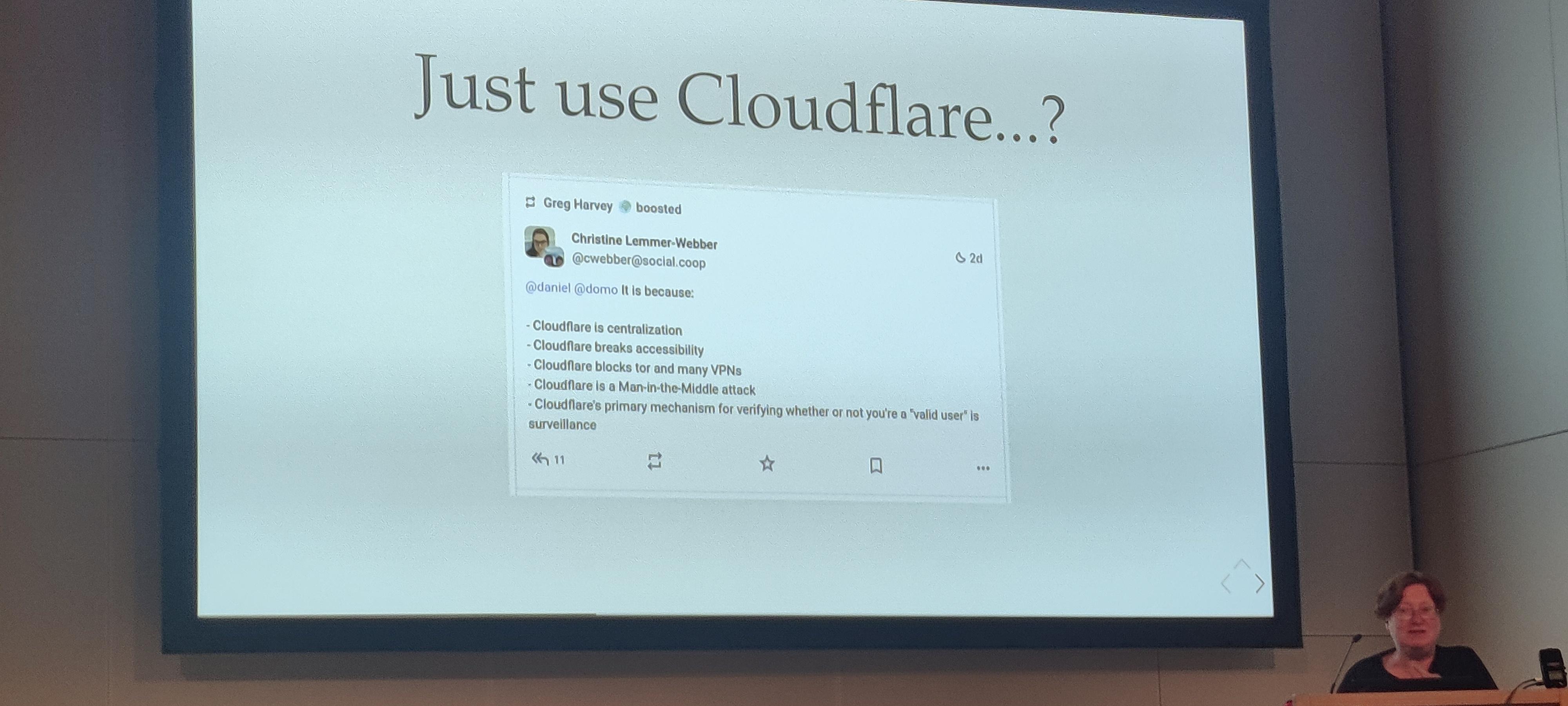- Home
- Categories
- Uncategorized
- I work in IT, had a manager show me an AI he wanted to deploy.
I work in IT, had a manager show me an AI he wanted to deploy.
-
I work in IT, had a manager show me an AI he wanted to deploy. I refused to unless it could successfully play 20 questions and guess an animal correctly. Its been a week and I haven't heard from him since. Try it, it never works.
-
 undefined Oblomov shared this topic on
undefined Oblomov shared this topic on
Gli ultimi otto messaggi ricevuti dalla Federazione
-
A log. But not a file.
Always stay strong, even when the waves of life crash upon you.
#Photography #Photo #Picture #Pic #Sea #Waves #Sky #Waves #MeerMittwoch #SeaWednesday
-
@mynameistillian the first time or two I get my hands on them each season I just wash them, put them in the oven at 180°C and cook them until they are soft when poked with a fork, and then eat them as is, enjoying the taste I had missed for the rest of the year.
this last time I had a bit of a leftover, and I've cut one of the baked sweet potatoes in cubes, dropped them in hot dashi (kombu-only) stock with a bit of wakame, heated the think for a couple of minutes more and then added miso, and I think it was even better than my usual quick miso soup with regular potatoes and wakame (they were the white variety of sweet potatoes, not the orange one)
-
Mozilla porta la VPN direttamente in Firefox. È gratis, ma non è una rivoluzione
#CyberSecurity
https://insicurezzadigitale.com/mozilla-porta-la-vpn-direttamente-in-firefox-e-gratis-ma-non-e-una-rivoluzione/
-
Summary of A Philosophy of Software Design by John Ousterhout
Source: danlebrero.comThese are notes by Daniel Lebrero Berna on John Ousterhout’s A Philosophy of Software Design.
Some advice in the book goes against the current software dogma. The current dogma is the result of previous pains, but has now been taken to the extreme, causing new pains.
What the author solves with “Comment-First Development,” others solve with Test-Driven Development. The excuses for not writing comments mirror those for not writing tests.
Key Insights It’s easier to see design problems in someone else’s code than your own. Total complexity = Σ(complexity of part × time spent on that part). Goal of good design: make the system obvious. Complexity accumulates incrementally, making it hard to remove. Adopt a “zero tolerance” philosophy. Better modules: interface much simpler than implementation (Deep modules). Design modules around required knowledge, not task order. Adjacent layers with similar abstractions are a red flag. Prioritize simple interfaces over simple implementations. Each method should do one thing and do it completely. Long methods are fine if the signature is simple and the code easy to read. Difficulty naming a method may indicate unclear design. Comments should add precision or intuition. If you aren’t improving the design when changing code, you’re probably making it worse. Comments belong in the code, not commit logs. Poor designers spend most of their time chasing bugs in brittle code. Preface The most fundamental problem in computer science is problem decomposition. The book is an opinion piece. The goal: reduce complexity. 1. Introduction (It’s All About Complexity) Fight complexity by simplifying and encapsulating it in modules. Software design is never finished. Design flaws are easier to see in others’ code. 2. The Nature of Complexity Complexity = what makes code hard to understand or modify. Total complexity depends on time spent in each part. Complexity is more obvious to readers than writers. Symptoms: change amplification, cognitive load, unknown unknowns. Causes: dependencies, obscurity. Complexity accumulates incrementally; remove it aggressively. 3. Working Code Isn’t Enough Distinguish tactical (short-term) from strategic (long-term) programming. The “tactical tornado” writes lots of code fast but increases complexity. 4. Modules Should Be Deep A module = interface + implementation. Deep modules have simple interfaces, complex implementations. Interface = what clients must know (formal + informal). Avoid “classitis”: too many small classes increase system complexity. Interfaces should make the common case simple. 5. Information Hiding (and Leakage) Information hiding is key to deep modules. Avoid temporal decomposition (ordering-based design). Larger classes can improve information hiding. 6. General-Purpose Modules Are DeeperMake modules somewhat general-purpose.
Implementation fits current needs; interface supports future reuse.
Questions to balance generality:
What is the simplest interface covering current needs? How many times will it be used? Is the API simple for current use? If not, it’s too general. 7. Different Layer, Different Abstraction Adjacent layers with similar abstractions are a red flag. Pass-through methods and variables add no value. Fix pass-throughs by grouping related data or using shared/context objects. 8. Pull Complexity Downwards Prefer simple interfaces over simple implementations. Push complexity into lower layers. Avoid configuration parameters; compute reasonable defaults automatically. 9. Better Together or Better Apart?Combine elements when they:
Share information. Are used together. Overlap conceptually. Simplify interfaces or eliminate duplication.Developers often split methods too much.
Methods can be long if they are cohesive and clear.
Red flag: one component requires understanding another’s implementation.
10. Define Errors Out of ExistenceException handling increases complexity.
Reduce exception points by:
Designing APIs that eliminate exceptional cases. Handling exceptions at low levels. Aggregating exceptions into a common type. Crashing when appropriate. 11. Design It Twice Explore at least two radically different designs before choosing. 12. Why Write Comments? The Four ExcusesWriting comments improves design and can be enjoyable.
Excuses:
“Good code is self-documenting.” False. “No time to write comments.” It’s an investment. “Comments get outdated.” Update them. “Comments are worthless.” Learn to write better ones. 13. Comments Should Describe Things That Aren’t Obvious Comments should add precision and intuition. Document both interface and implementation. 14. Choosing Names Names should be precise and consistent. If naming is hard, the design likely isn’t clean. 15. Write the Comment First Like TDD, comment-first helps design, pacing, and clarity. 16. Modifying Existing Code Always improve design when changing code. Comments belong in code, not commit logs. 17. Consistency Don’t “improve” existing conventions without strong reason. 19. Software Trends Agile and TDD often promote tactical programming. 20. Designing for Performance Simpler code tends to be faster. Design around the critical path. 21. Conclusion Poor designers spend their time debugging brittle systems.
-
Stop using Cloudflare, not only according to us for GDPR reasons.
@cwebber told you as well. Shown in Antjes @ifrik talk at #drupalCon
-
Summary of Clean Code by Robert C. Martin
Source: gist.github.com/wojtekluCode is clean if it can be understood easily – by everyone on the team. Clean code can be read and enhanced by a developer other than its original author. With understandability comes readability, changeability, extensibility, and maintainability.
General rules Follow standard conventions. Keep it simple stupid. Simpler is always better. Reduce complexity as much as possible. Boy scout rule. Leave the campground cleaner than you found it. Always find root cause. Always look for the root cause of a problem. Design rules Keep configurable data at high levels. Prefer polymorphism to if/else or switch/case. Separate multi-threading code. Prevent over-configurability. Use dependency injection. Follow Law of Demeter. A class should know only its direct dependencies. Understandability tips Be consistent. If you do something a certain way, do all similar things in the same way. Use explanatory variables. Encapsulate boundary conditions. Boundary conditions are hard to keep track of. Put the processing for them in one place. Prefer dedicated value objects to primitive type. Avoid logical dependency. Don't write methods which work correctly depending on something else in the same class. Avoid negative conditionals. Names rules Choose descriptive and unambiguous names. Make meaningful distinction. Use pronounceable names. Use searchable names. Replace magic numbers with named constants. Avoid encodings. Don't append prefixes or type information. Functions rules Small. Do one thing. Use descriptive names. Prefer fewer arguments. Have no side effects. Don't use flag arguments. Split method into several independent methods that can be called from the client without the flag. Comments rules Always try to explain yourself in code. Don't be redundant. Don't add obvious noise. Don't use closing brace comments. Don't comment out code. Just remove. Use as explanation of intent. Use as clarification of code. Use as warning of consequences. Source code structure Separate concepts vertically. Related code should appear vertically dense. Declare variables close to their usage. Dependent functions should be close. Similar functions should be close. Place functions in the downward direction. Keep lines short. Don't use horizontal alignment. Use white space to associate related things and disassociate weakly related. Don't break indentation. Objects and data structures Hide internal structure. Prefer data structures. Avoid hybrids structures (half object and half data). Should be small. Do one thing. Small number of instance variables. Base class should know nothing about their derivatives. Better to have many functions than to pass some code into a function to select a behavior. Prefer non-static methods to static methods. Tests One assert per test. Readable. Fast. Independent. Repeatable. Code smells Rigidity. The software is difficult to change. A small change causes a cascade of subsequent changes. Fragility. The software breaks in many places due to a single change. Immobility. You cannot reuse parts of the code in other projects because of involved risks and high effort. Needless Complexity. Needless Repetition. Opacity. The code is hard to understand.
-
@gubi
La spesa militare ITA non è mai stata nemmeno il 2% che da decenni promettiamo alla NATO.
L'esercito ITA di certo non è pronto a nulla e di certo non è pronto ad una guerra come quella che sta subendo UKR.
Che la Russia o suoi proxie non siano una minaccia lo credono solo quelli che credono ai Russi.
L'aspettativa di vita ITA è seconda solo al Giappone, ma abbiamo vita lavorativa più corta della Germania.Vogliamo mettere altro debito sui giovani?
Non basta quello che hanno già?
Post suggeriti
-
A log.
Watching Ignoring Scheduled Pinned Locked Moved Uncategorized photography photo picture pic sea waves sky meermittwoch 1
0 Votes1 Posts0 Views
1
0 Votes1 Posts0 Views -
Stop using Cloudflare, not only according to us for GDPR reasons.@cwebber told you as well.
Watching Ignoring Scheduled Pinned Locked Moved Uncategorized drupalcon 1
0 Votes1 Posts0 Views
1
0 Votes1 Posts0 Views -
I francesi sono scesi in piazza e hanno bloccato la riforma delle pensioni, almeno fino alle prossime presidenziali.
Watching Ignoring Scheduled Pinned Locked Moved Uncategorized0 Votes4 Posts0 Views -
Which software design principles do you rely on most?
Watching Ignoring Scheduled Pinned Locked Moved Uncategorized programming0 Votes3 Posts1 Views